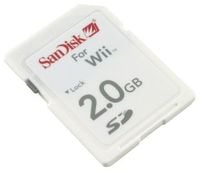SD card
Secure Digital cards, more commonly referred to as SD cards, are a digital, flash-based storage medium. Initially intended for digital cameras, SD cards have attained widespread use as a storage medium, and it has since been used on various Nintendo consoles as an alternate storage device.
In Super Smash Bros. Brawl
The Wii has a single SD card slot on it, with the console being able to write some data and software onto SD cards. The Wii only supported SD cards no larger than 2 gigabytes on launch, but later firmware updates allowed it to read SDHC cards, SD cards that can support over 2 gigabytes of data.
Standard save data for Super Smash Bros. Brawl (and all Wii games) is not saved to SD cards (and it can't be copied). Instead, data is stored on the Wii's own flash-based memory. SD cards, however, can be used to save snapshots, custom stages and replays from the Vault in order to be used or transferred on other Wii consoles. Brawl only supports SD cards that can support no more than 2 gigabytes of data, as it was released before the Wii could take advantage of SDHC cards and the game itself could not be patched in light of this; the use of hacks, however, can force Brawl to read SDHC cards.
Use in hacking
Through the use of an exploit in Brawl's Stage Builder, it is possible to load customised or otherwise hacked data from an SD card. In addition to allowing for the download of The Homebrew Channel, this also allows for the loading of replacement files, as well as gameplay mods such as Project Mand Balanced Brawl. Through the use of other hacks, it is also possible to force Brawl to read SDHC cards.
In Super Smash Bros. 4
In Super Smash Bros. for Nintendo 3DS
The Nintendo 3DS has the ability to save downloaded software and various other types of data to an SD card, and all iterations of the console come packaged with an SD card of some sort; the 3DS includes a two gigabyte SD card, the 3DS XL and 2DS include a four gigabyte card, and the New Nintendo 3DS and New Nintendo 3DS XL include a four gigabyte microSD card.
In Super Smash Bros. for Nintendo 3DS, various types of data are saved to the Nintendo 3DS's SD card rather than its internal memory. Save data takes up 48 "blocks" of memory (or 6 megabytes), and the game's updates also take up varying amounts of space, with version 1.0.5 requiring 1010 blocks (or about 126.25 megabytes). Additionally, if the game is digitally downloaded via the Nintendo eShop, then all of the game's data is saved to the SD card. Snapshots also returned for Super Smash Bros. 4 and are also saved to the SD card, though they can be transferred to the Nintendo 3DS's internal memory if they are accessed via the Nintendo 3DS Camera application.
In Super Smash Bros. for Wii U
The Wii U also features an SD card slot, with Super Smash Bros. for Wii U requiring an SD card to capture and save snapshots. Smash 4 is uniquely the only Wii U game that can take advantage of the console's SD card slot. If run on a Wii U, Brawl also features full compatibility with SD cards.
Use in hacking
A SD card can be used to hack a Wii U by exploiting the console's network connectivity through the Internet browser. By using a xampp server to stream critical data to a website via one's IP address, it forces the Wii U to recognize anything stored on the SD card as game update data upon the boot up of said game. Once either the game is closed out, the console is turned off, or the SD card is removed, everything returns to as it was before.[1]
Like with the Wii, custom data, hacks, and exploits can be loaded on the 3DS via the SD Card. Many ways of hacking the 3DS using an SD card exist, but they all involve placing files on the SD card that trigger a certain response from the console and allow custom data to be loaded. Through this, it becomes possible to use custom files and cheats for Smash 3DS by placing them on the SD Card and running them accordingly. A homebrew exploit using Smash 3DS as well as a custom file on the SD Card also exists though it was patched via a game update.
In Super Smash Bros. Ultimate
The Nintendo Switch also features an SD card slot; unlike the consoles before it, however, the system only supports micro SD cards. Like on the Wii U and 3DS, downloaded applications can be saved to an SD card instead of its eMMC chip, though unlike before the Switch does not natively allow the storage of save data on an SD card.
Ultimate saves all snapshots to internal storage by default, after which they can be moved to an SD card. Unlike in Brawl, custom stages cannot be put onto an SD card.

